JB74 Jimny warning lights and messages
One of the areas of major misinformation when it comes to a generation 4 Jimny is around warning lights and warning messages. Specifically, people make incorrect assumptions around what some of the warnings might mean, or they may not totally understand what each warning light or message represents.
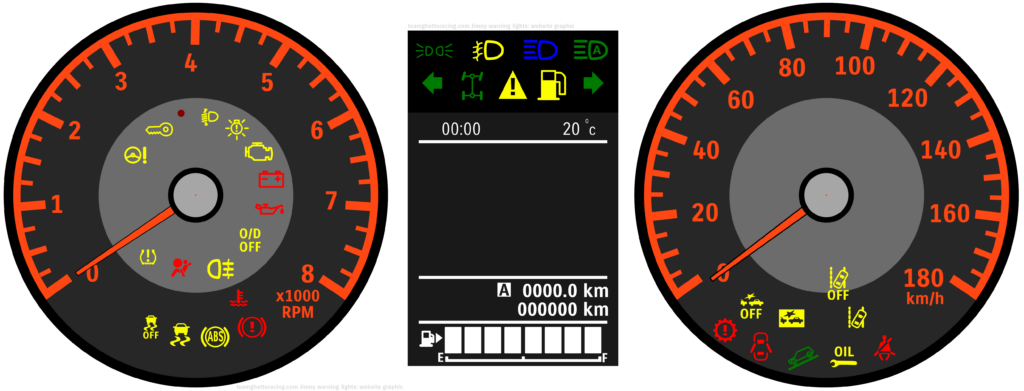
To make this a bit more manageable, I’ve broken it up into 4 sections along with some background:
- Warning lights in the speedometer
- Warning lights in the tachometer
- Warning lights in the central display
- Warning messages in the central display
Background
Some basic principles before we begin:
- Almost all warning lights and messages will have multiple causes. Sometimes, particular combinations of warning messages and lights are diagnostic, but this is not always the case. If in doubt, you really need to go through a full diagnostic procedure to extract codes from all modules to try to start to understand symptoms and therefore what the fix will be.
Just remember: diagnostic codes are symptoms, not causes. You might think you’re fixing the issue but it’s down to something more underlying and it is worth digging into that before you go loading up the parts cannon. - The warning lights and dash colours have meanings that are worth understanding.
- For lights:
- Green lights are a type of ‘information’ light.
Everything’s fine, just something is happening that might be useful to know about. Examples of this include the 4wd hub light for 4wd engagement, or hill descent mode - Blue lights are another type of information light, but are for alternate states.
Examples of this might be high beam headlights are depicted with a blue light, or the blue light for ‘coolant is below 50º C’ information light. - Yellow/amber lights are base level warnings.
These are, essentially, something is happening that’s a bit out of the ordinary but not a ‘stop the car’ kind of warning. Check engine lights, issues with blown globes, or even certain safety features disabled are displayed in this colour - Red lights are a ‘stop the car’ kind of a warning light.
Battery voltage, oil pressure, overheating coolant, or brake warnings are all things you probably shouldn’t be driving the car with these displayed. (At least not without understanding what’s going on and limping to somewhere safer, per se).
- Green lights are a type of ‘information’ light.
- As for dash colours:
- White is the default colour for the Australian delivered Jimny dash information panel
- Yellow dash colours indicate that there’s some issue to be aware of, or the car is in an alternate state.
ESP maintenance mode or some issue has arisen with the autonomous braking system would be two possibilities where you could get this warning - Red dash colours are for serious issues
If you see this you might have triggered the autonomous braking system, or some other serious fault has arisen with the car.
- Not all of the warning lights I will show here are valid for Australian delivered cars, but I am including them for completeness.
Since I draw on my own tests with my own car, I haven’t covered a couple of the key warnings that might come up with a 5 door Jimny such as adaptive cruise control or stop-start system stuff, though.
Let’s begin!
Speedometer warning lights
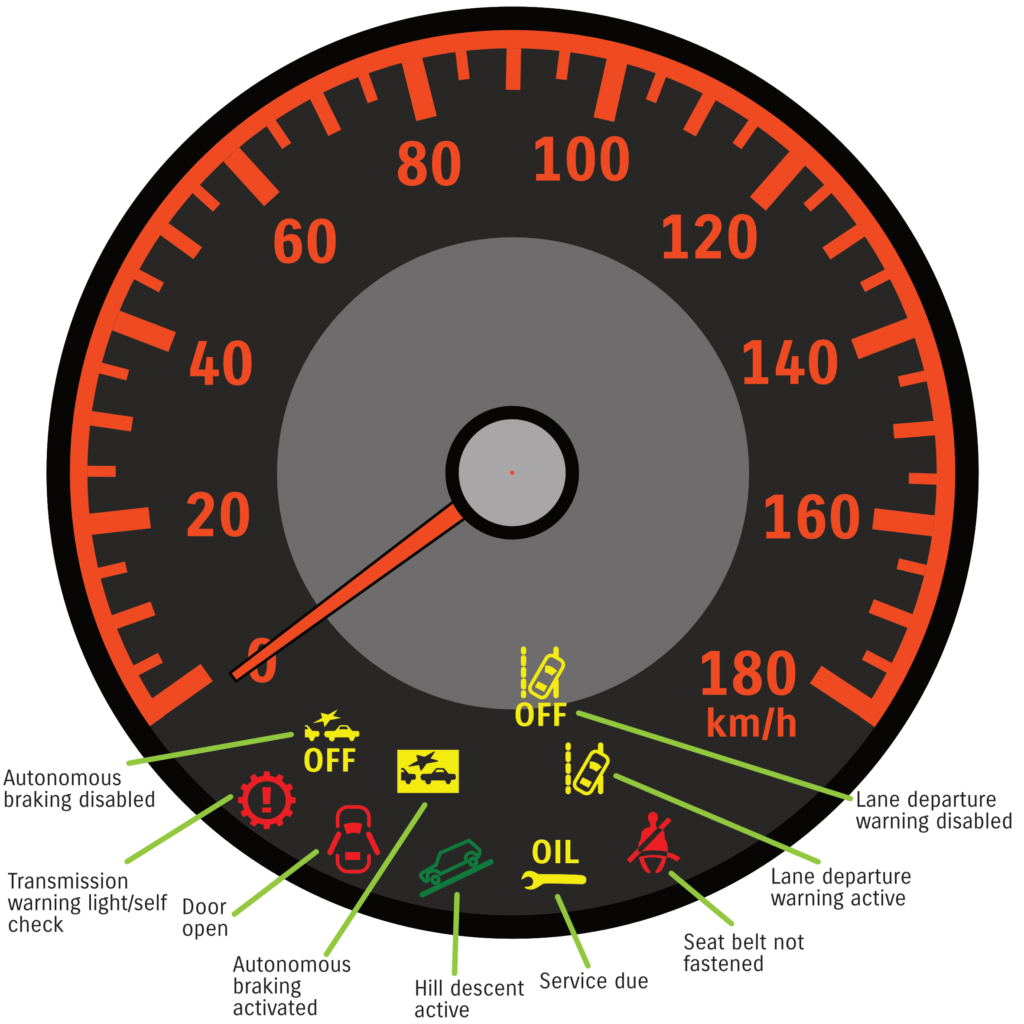
Working through these and what they mean:
Autonomous braking disabled describes pretty much what this light means. This means the autonomous braking system is currently not active. You can disable it with the switch to the drivers side on the dashboard, but you will also see this light if you have an error in the autonomous braking system and the system is therefore not active.
If you disable autonomous braking yourself using the switch then it will be re-enabled upon next ignition start.
Autonomous braking activated light comes up when the autonomous braking system is working, i.e. it is actively trying to avoid a collision. You are unlikely to notice this light due to the buzzer going off at the same time, the dashboard going red in the central display and the car braking quite heavily.
Lane departure warning disabled also perfectly describes what this light means. Again, this will display if you turn off the lane departure warning using the switch on the dashboard, but it will also be displayed if there is some error disabling it. Unlike the autonomous braking system, lane departure warning remains disabled until you re-enable it if you have turned it off using the switch.
Lane departure warning active light will flash when the car detects you are departing a lane without indicating.
Transmission warning light/self check is only for automatic vehicles. This will (should? – I don’t have an auto to check) show up on initial key on as the transmission control module goes through a self check. If there is an error detected in the transmission then this light will illuminate.
Door open light will illuminate if the car sees a door open (including the boot).
Hill descent active is a light that will show up when you engage hill descent mode off road. It will be illuminated when that has been pressed, and it will flash when it is actually active i.e. actively working to slow you down when you are descending a hill.
Service due light does not appear to be activated for the Australian market, but for markets where it is then this will illuminate when sufficient time or km has passed since the service reminder was last reset.
Seat belt not fastened is a light showing when a seatbelt is not fastened in a seat which is occupied.
Tachometer warning lights
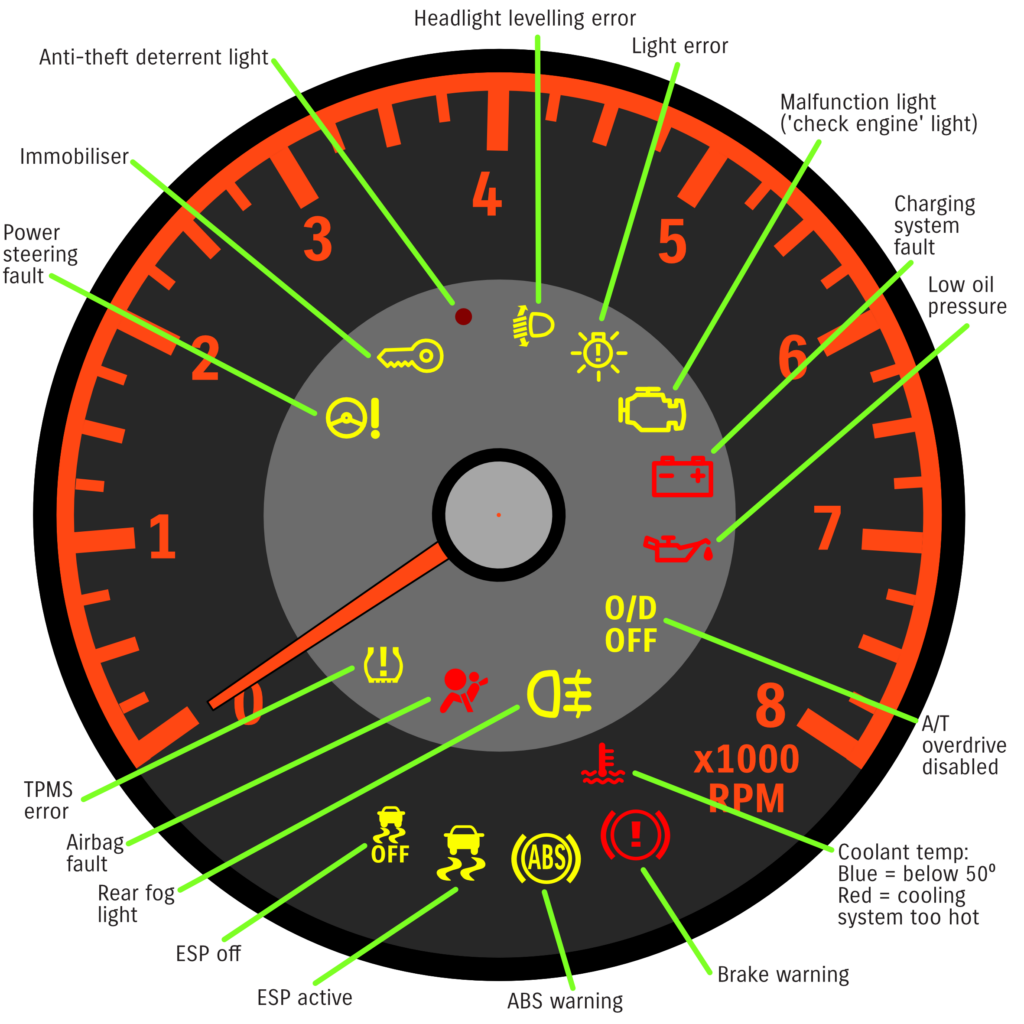
Power steering fault is any fault that causes an error in the power steering module. This can be steering angle sensor disagreement, but also a bunch of other errors.
Immobiliser will show up when the immobiliser does not recognise a key, or some other error in the immobiliser module, e.g. the antenna cannot receive a signal from a valid key when you are trying to start the car.
Anti-theft deterrent light is an LED that flashes intermittently when the car is locked.
Headlight levelling error will show up for any error in the levelling circuitry.
Light error is when the car detects a blown globe. I haven’t seen this even for taillights blown, but it only appears to pop up for issues with LED headlights or headlight globes in lites with halogen headlights.
The malfunction light, often called the ‘check engine light‘, will show up for a huge range of errors in various modules. If it flashes then it is likely to be a more serious error than if it just is a solid light.
Charging system fault is when your car has a low battery voltage or the alternator is not providing sufficient charge to recharge the battery.
Low oil pressure is what it says: your car has low oil pressure. If this shows up when driving then you should stop the car immediately.
O/D OFF will show up when you press the O/D off button on the automatic transmission shifter. This means the car is locked out of going into 4th (top) gear in the transmission, and will not lock up the torque converter in 3rd either. Generally, you would do this when you want to force the car to stay in 3rd gear for some reason, such as towing and approaching a hill.
Coolant temp light shows up in two different colours. When the car is cold, it will show up in blue until the coolant temperature reaches 50º. When the car is overheating, the light will illuminate red. You won’t see it otherwise. If it blinks red then there is some error in the coolant temperature sensor.
Brake warning often gets called the handbrake warning light, but it is broader than that. While it shows up whenever the handbrake is on, it will also show up for low brake fluid. If your handbrake is down and this shows up when driving then you should check the brake fluid level.
ABS warning shows up for errors in the ABS/ESP system.
ESP active shows up either for faults in the ESP system (shown as solid) or flashes when the car is using the ESP system or engaging traction control. This is useful to look for if you want to look for what system is activating in the car in some circumstance. People often blame the autonomous braking system for where the ESP system has intervened and vice-versa.
ESP off like many of the other ‘off’ lights does what it says: this shows up when ESP is disabled.
TPMS warning shows up for tyre pressure issues; only shown on cars with a TPMS system installed (so, not on Australian cars).
Airbag light comes up for any fault in the airbag system. This can be as complex as an airbag or seatbelt pretensioner has been activated, but it can be as simple as an airbag connector has been disconnected under one of the front seats.
Rear fog light shows up when the rear fog light is turned on, but this only applies to cars with a rear fog light (so not Australian cars).
Central display warning lights
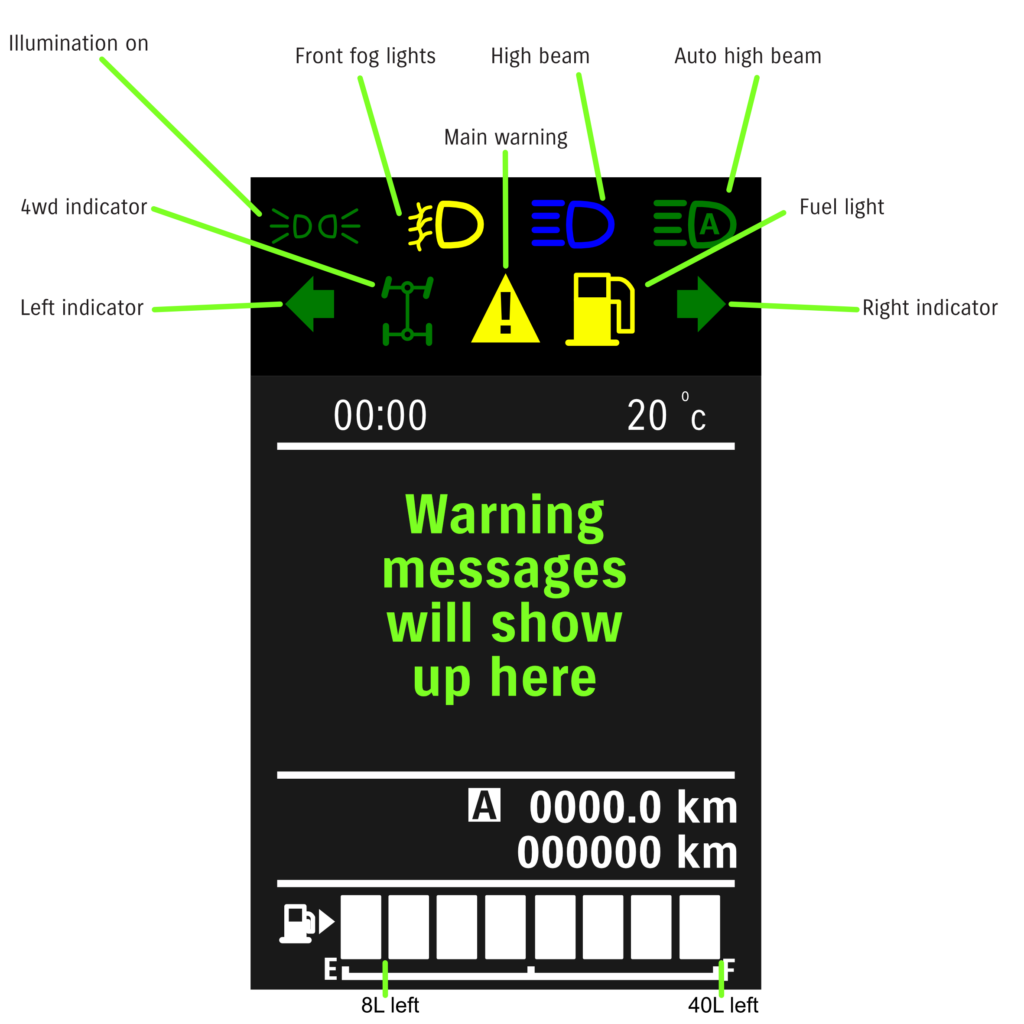
Illumination on shows when the car has any of the lights on: side/park lights, headlights etc. It will be off in the daytime when no lights are on other than the DRLs.
Front fog light indicator will show up when the front fog lights are turned on.
High beam indicator light when the car has high beams on; if you have the auto high beams on then this will happen when the car detects it is able to put on the high beams and you are travelling at more than 40 km/h. If the headlights are in the on position, then you will see this only when you have the headlight stalk pushed forwards.
Auto high beam indicator shows in green when the car is in auto high beam enabled mode (headlight stalk forwards, headlights in ‘AUTO’ position). This indicator will show in amber/yellow when the system has an error and auto high beams are disabled, e.g. there is a malfunction in the camera system.
Left and right indicators show up when the car is showing the left or right indicators, or both in the case of hazard lights activation.
4wd indicator is the light that shows when you have engaged 4wd. It will flash as the car is locking the automatic hubs when you engage 4H; it will then go solid when the car has seen sufficient vacuum long enough in the vacuum system to ensure the hubs are engaged. If it flashes when you are in 4wd then it has detected a malfunction. It will also flash when you disengage 4wd (i.e. shift back to 2H).
Fuel light shows up when you are reaching a low fuel level. It first turns on with about 10L to 8L remaining, and then flashes with 5-3L remaining in the tank.
Main warning is the generic warning for any system issue that requires attention, and it will flash or display solidly for various errors.
Fuel gauge has 8 bars which indicate fuel remaining. For a stock tank, totally full is 40L and 8 bars shown. When you get to 8L remaining then you will get to the final bar.
Warning messages
There are a range of warning messages that can show up in the middle of the central display. I will eventually catalogue all of them here, but there are multiple classes.
Cruise control
ESP system warnings
Lots to cover here!
Autonomous braking warnings
I cover these warnings and troubleshooting in more details in my diagnostic codes article, but for a summary I’ve got the key elements here too.
Collision warning
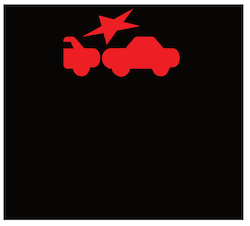
The following conditions trigger this:
- Your speed is between 15 and 140 km/h for a stopped vehicle ahead; or,
- Your speed is between 15 and 60 km/h for a pedestrian in front of the vehicle; or,
- Relative speed between you and a vehicle or pedestrian is > 15 km/h,
This mode is just a warning, it will not intervene at this point but just alert you that you need to take action.
Brake assist
If the following conditions are met:
- Your speed is between 15 and 80 km/h for a stopped vehicle ahead; or,
- Your speed is between 15 and 60 km/h for a pedestrian in front of the vehicle; or,
- Relative speed between you and a vehicle or pedestrian is > 15 km/h; and,
- The brake pressure is insufficient to slow the vehicle to a stop in time before a collision will occur,
then the same graphic as shown above and buzzer will alert, but the car will command the ABS/ESP unit to add brake line pressure to assist the car in slowing down.
Autonomous braking
The autonomous braking is the most severe of the interventions the car’s collision avoidance system can take. This is activated if the following requirements are met:
- Your speed is between 5 and 100 km/h for a stopped vehicle ahead; or
- Your speed is between 15 and 60 km/h for a pedestrian in front of the vehicle; or
- Relative speed between you and a vehicle or pedestrian is > 5 km/h; and,
- A collision will occur,
then the car will automatically apply the brakes along with sounding the warning buzzer and flashing the warning. Note that the speed differential part is the key here: this system will brake you even if you are initially doing > 100 km/h despite the first condition.
Ultimately a lot of people never get to the autonomous braking phase; when they talk about getting phantom collision warnings they are generally only getting the first warning (red warning on the gauge cluster central display and the buzzer sounding).
Lane departure
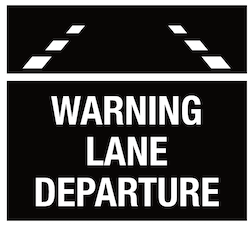
If the camera system detects a lane departure, the system will command a light steering wheel shake and display a lane departure warning in the central LCD display in the gauge cluster. It will also show the lane departure active warning light in the speedometer.
Vehicle swaying
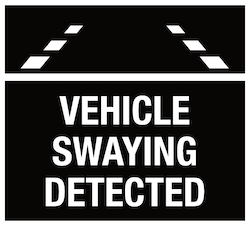
In addition to lane departure, it is possible for the Jimny to detect swaying within a lane and take corrective action to limit this swaying.
Temporary error disabling DSBS
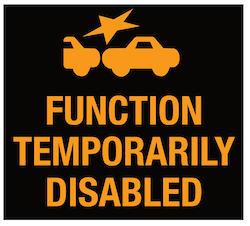
One potential error that you might see is the ‘function temporary disabled’ with an orange/yellow text rather than white or red. This is used for some temporary issues like some types of CAN connectivity or disagreement between sensors.
System malfunction
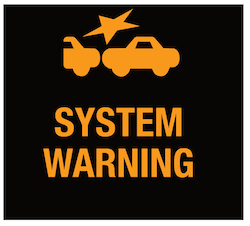
This is really the catch-all error and gives you an orange “system warning” error on the central LCD panel on the gauge cluster. This is generally a more permanent error than a sensor or CAN communication failure. If it comes on within 5-10 seconds of ignition on then it is a failure of the autonomous braking self check; if it comes on instantly it is a power or fuse issue; if it comes on intermittently when driving then it will be CAN communication or sensor errors.
Camera visibility
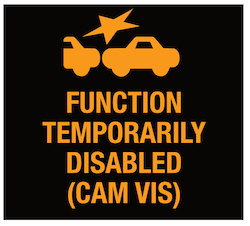
This is the most commonly seen error and people often ask what’s wrong with their car when they see this error. As the name implies, this error relates to the visibility of the camera. Dirt on the windscreen in front of the camera, heavy rain, mist on the inside of the windscreen/camera module, or even opening your bonnet and starting your car will give you this error.
DSBS internal temperature too high
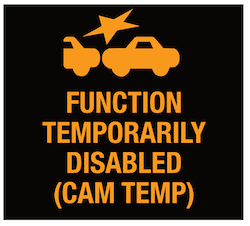
The final type of error is the error relating to the camera system overheating. This, as the name implies, is most likely to happen on hot days or when parking in the sun. Driving with the air conditioning on and cooling the cabin often appears to be sufficient to clear this error.
